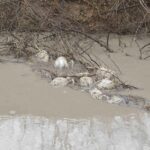At approximately 11 p.m. on Thursday, Hurricane Helene landed in Florida’s Big Bend area. The Category 4 storm has claimed three lives and paralyzed approximately 1.3 million civilians in Florida with power outages, according to the utility tracker PowerOutage.us.
The National Hurricane Center alerted civilians that Helene would bring a “life-threatening” storm surge, strong winds, and heavy rain. The center added that “tropical storm conditions are occurring from southern Florida to southeastern Georgia, and these conditions will continue spreading northward across the tropical storm warning areas in the Southeastern U.S. through today.”
The International Space Station flew over Hurricane Helene at 2:25 p.m. EDT Thursday, Sept. 26, 2024, as it approached the Gulf Coast of Florida packing winds in excess of 120 miles an hour. pic.twitter.com/J1iU0Iztpx
— International Space Station (@Space_Station) September 26, 2024
Forecasters expect rainfall to reach 15-20 feet above the ground in Florida’s Big Bend area, from Carrabelle to the Suwannee River. Surrounding areas can anticipate 3–15 feet of water, according to the hurricane center. Jamie Rhome, a deputy director at the hurricane center, informed CBS News that “the water impacts are probably going to be the most impactful part of the storm, the most deadly part of the storm.”
Florida governor Ron DeSantis has cautioned Floridians not to travel hundreds of miles from their homes to flee the storm because Helene was expected to move inland after making landfall. Alternatively, the governor urged civilians to move to higher ground in their localities by moving to a friend or family member’s house or a nearby shelter.
According to Climate Central, recorded water temperatures are significantly impacted by human-induced climate change. In 2024, the North Atlantic Ocean will have experienced unprecedented warmth, absorbing 90% of the excess heat generated by greenhouse gas emissions. Sea temperatures along Hurricane Helene’s direct path were as warm as 31.67 degrees Celsius, 2 to 4 degrees above the norm.






